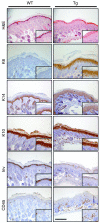Elastase 2 is expressed in human and mouse epidermis and impairs skin barrier function in Netherton syndrome through filaggrin and lipid misprocessing
- PMID: 20179351
- PMCID: PMC2827963
- DOI: 10.1172/JCI41440
Elastase 2 is expressed in human and mouse epidermis and impairs skin barrier function in Netherton syndrome through filaggrin and lipid misprocessing
Abstract
The human epidermis serves 2 crucial barrier functions: it protects against water loss and prevents penetration of infectious agents and allergens. The physiology of the epidermis is maintained by a balance of protease and antiprotease activities, as illustrated by the rare genetic skin disease Netherton syndrome (NS), in which impaired inhibition of serine proteases causes severe skin erythema and scaling. Here, utilizing mass spectrometry, we have identified elastase 2 (ELA2), which we believe to be a new epidermal protease that is specifically expressed in the most differentiated layer of living human and mouse epidermis. ELA2 localized to keratohyalin granules, where it was found to directly participate in (pro-)filaggrin processing. Consistent with the observation that ELA2 was hyperactive in skin from NS patients, transgenic mice overexpressing ELA2 in the granular layer of the epidermis displayed abnormal (pro-)filaggrin processing and impaired lipid lamellae structure, which are both observed in NS patients. These anomalies led to dehydration, implicating ELA2 in the skin barrier defect seen in NS patients. Thus, our work identifies ELA2 as a major new epidermal protease involved in essential pathways for skin barrier function. These results highlight the importance of the control of epidermal protease activity in skin homeostasis and designate ELA2 as a major protease driving the pathogenesis of NS.
Figures








Similar articles
-
[Elastase 2, a key player in the integrity of the epidermal barrier and in Netherton syndrome].Med Sci (Paris). 2010 Aug-Sep;26(8-9):681-5. doi: 10.1051/medsci/2010268-9681. Med Sci (Paris). 2010. PMID: 20819697 French. No abstract available.
-
Netherton syndrome: skin inflammation and allergy by loss of protease inhibition.Cell Tissue Res. 2013 Feb;351(2):289-300. doi: 10.1007/s00441-013-1558-1. Epub 2013 Jan 24. Cell Tissue Res. 2013. PMID: 23344365 Review.
-
KLK5 Inactivation Reverses Cutaneous Hallmarks of Netherton Syndrome.PLoS Genet. 2015 Sep 21;11(9):e1005389. doi: 10.1371/journal.pgen.1005389. eCollection 2015 Sep. PLoS Genet. 2015. PMID: 26390218 Free PMC article.
-
Transgenic kallikrein 5 mice reproduce major cutaneous and systemic hallmarks of Netherton syndrome.J Exp Med. 2014 Mar 10;211(3):499-513. doi: 10.1084/jem.20131797. Epub 2014 Feb 17. J Exp Med. 2014. PMID: 24534191 Free PMC article.
-
The emerging roles of serine protease cascades in the epidermis.Trends Biochem Sci. 2009 Sep;34(9):453-63. doi: 10.1016/j.tibs.2009.08.001. Epub 2009 Aug 31. Trends Biochem Sci. 2009. PMID: 19726197 Review.
Cited by
-
Protease-Activated Receptor 2 in inflammatory skin disease: current evidence and future perspectives.Front Immunol. 2024 Sep 5;15:1448952. doi: 10.3389/fimmu.2024.1448952. eCollection 2024. Front Immunol. 2024. PMID: 39301020 Free PMC article. Review.
-
Deimination of human filaggrin-2 promotes its proteolysis by calpain 1.J Biol Chem. 2011 Jul 1;286(26):23222-33. doi: 10.1074/jbc.M110.197400. Epub 2011 Apr 29. J Biol Chem. 2011. PMID: 21531719 Free PMC article.
-
Comel-Netherton syndrome: A local skin barrier defect in the absence of an underlying systemic immunodeficiency.Allergy. 2020 Jul;75(7):1710-1720. doi: 10.1111/all.14197. Epub 2020 Feb 21. Allergy. 2020. PMID: 31975472 Free PMC article.
-
KLK5 and KLK7 Ablation Fully Rescues Lethality of Netherton Syndrome-Like Phenotype.PLoS Genet. 2017 Jan 17;13(1):e1006566. doi: 10.1371/journal.pgen.1006566. eCollection 2017 Jan. PLoS Genet. 2017. PMID: 28095415 Free PMC article.
-
A mechanistic target of rapamycin complex 1/2 (mTORC1)/V-Akt murine thymoma viral oncogene homolog 1 (AKT1)/cathepsin H axis controls filaggrin expression and processing in skin, a novel mechanism for skin barrier disruption in patients with atopic dermatitis.J Allergy Clin Immunol. 2017 Apr;139(4):1228-1241. doi: 10.1016/j.jaci.2016.09.052. Epub 2016 Nov 29. J Allergy Clin Immunol. 2017. PMID: 27913303 Free PMC article.
References
-
- Uchida Y, et al. Epidermal sphingomyelins are precursors for selected stratum corneum ceramides. J Lipid Res. 2000;41(12):2071–2082. - PubMed
Publication types
MeSH terms
Substances
Grants and funding
LinkOut - more resources
Full Text Sources
Other Literature Sources
Molecular Biology Databases
Miscellaneous

